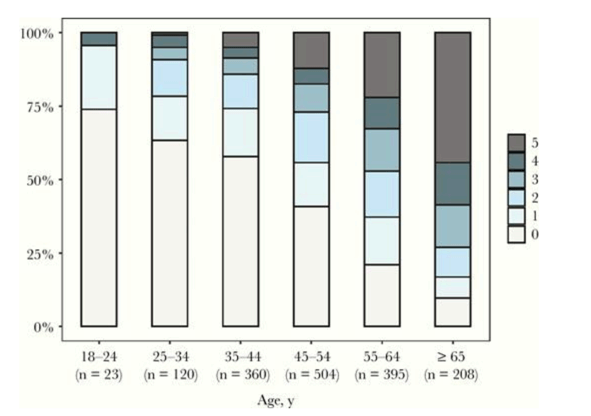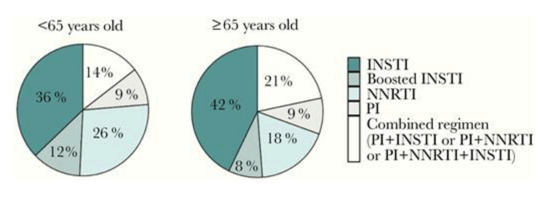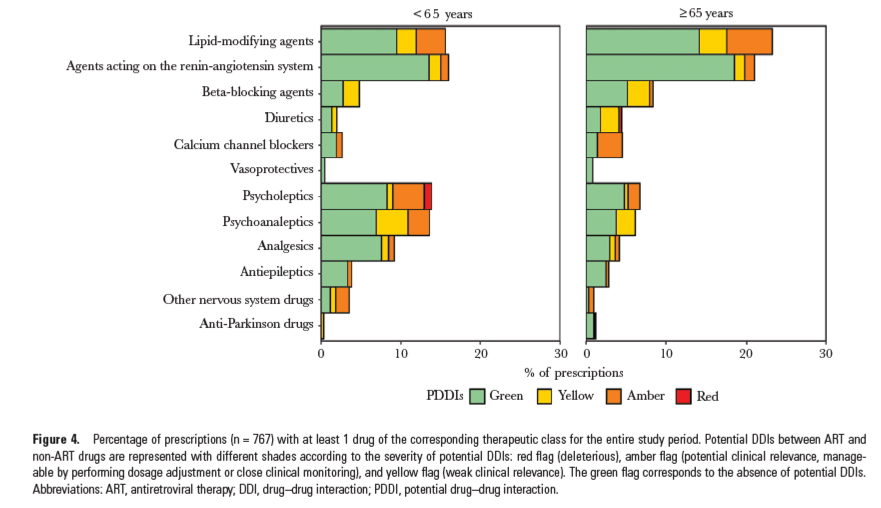| |
Polypharmacy, Drug-Drug Interactions, and Inappropriate Drugs:
New Challenges in the Aging Population With HIV
|
| |
| |
Download the PDF here
Polypharmacy is completely out of hand with some elderly PLWH taking 15-22 medications a day + their ARTs. Deprescribing has been getting a lot of discussion, meaning reducing the number of medications a person is taking. Jules
..... (31%) had a least 1 PIM, mostly benzodiazepines and hypnotics (n = 19, 27% of PIM: potentially inappropriate medications). Three PWH received drugs characterized by a high anticholinergic burden......elderly PWH tended to use a higher number of comedications (median [range], 4 [0-22]) compared with younger PWH (median [range], 1 [0-14]; P < .001). Ninety percent (n = 188) of the medication forms completed by elderly PWH included at least 1 comedication. elderly PWH tended to use a higher number of comedications (median [range], 4 [0-22])....Polypharmacy was more prevalent in PWH ≥65 years (44%; >5 comedications) compared with the younger group (12%).
Polypharmacy was defined as the concurrent administration of 5 or more comedications in addition to ART, which represents a rather conservative criterion, as the overall number of 5 drugs is commonly used to define polypharmacy
The aim of this study was to compare prescribed medications, polypharmacy, and potential DDIs between young and elderly PWH included in 2 centers of the Swiss HIV Cohort Study (SHCS). The prevalence of PIMs - potentially inappropriate medications - was assessed in the elderly group. In addition, dosage adjustment was evaluated for comedications for which official dosing recommendations are available in order to assess the management of DDIs in real life.
Our findings provide evidence that a high proportion of aging PWH are polymedicated and that the overall burden of medications has shifted from ARTs to treatments for other comorbidities. Our result demonstrating that 44% of elderly PWH are polymedicated is in line with recent studies reporting a rate of 37% [32, 33]. Cardiovascular and CNS drugs were the most represented therapeutic classes in older and younger PWH, respectively. This is in agreement with a previous [24] and a more recent analysis of the SHCS [34], showing that cardiovascular disease is the first cause of comedication prescription, followed by depression. In addition to a higher number of comedications, elderly PWH received more complex ART regimens, characterized by a higher propensity to cause DDIs, than younger patients, thus further complicating their treatment. These associations of multiple ART drugs are likely to result from of a longer history of HIV infection, with the acquisition of drug resistance leading to the need for more complex ARTs. Indeed, most of the younger PWH (39%) started their ARTs between 2000 and 2009, whereas half of the elderly PWH received their first ARTs between 1990 and 1999.
In conclusion, high rates of polypharmacy and the consequent DDI potential suggest that particular attention is needed when prescribing treatments to elderly PWH. Although the use of unboosted INSTIs is growing, one-fourth of elderly PWH had complex ARTs acting as perpetrator of DDIs. The acknowledgment that some medications may be inappropriate for aged patients constitutes an additional burden in health care provision to elderly PWH. Thus with the aging HIV population, education on geriatric medicine principles and periodic review of medicines is warranted to limit the risk of inappropriate prescribing in this vulnerable population. Clinicians should maintain a proactive approach for the recognition and management of potential DDIs, as well as for other prescribing issues traditionally encountered in geriatric medicine.
Thirty-eight elderly patients .(31%) had a least 1 PIM,. mostly .benzodiazepines and hypnotics. (n = 19, 27% of PIM). Three PWH received drugs characterized by a high anticholinergic burden (anticholinergic risk scale = 3), that is, dimenhydrinate, quetiapine, and trimipramine
As expected, the number of prescribed comedications increased with age (Figure 2). Considering all the 1610 collected forms, elderly PWH tended to use a higher number of comedications (median [range], 4 [0-22]) compared with younger PWH (median [range], 1 [0-14]; P < .001). Ninety percent (n = 188) of the medication forms completed by elderly PWH included at least 1 comedication. Polypharmacy was more prevalent in PWH ≥65 years (44%) compared with the younger group (12%). As indicated in Figure 3, drugs belonging to the cardiovascular class were the most utilized in the elderly group (73% of medication forms of elderly PWH included at least 1 cardiovascular drug), whereas CNS drugs were most commonly prescribed in younger PWH (26% of forms of younger PWH included at least 1 CNS medication). Calcium/vitamin D3 and acetylsalicylic acid (prescribed as an antithrombotic agent) were the most prescribed medications in their respective therapeutic classes (33% and 52%, respectively). With the exception of CNS drugs, the use of the most prescribed therapeutic classes (ie, cardiovascular, alimentary tract and metabolism, blood and blood-forming organs) increased in an exponential way with increasing age.

Polypharmacy, Drug-Drug Interactions, and Inappropriate Drugs: New Challenges in the Aging Population With HIV
Open Forum Infectious Diseases
21 December 2019
Abstract
Background
Antiretroviral therapy has transformed HIV infection from a deadly into a chronic condition. Aging people with HIV (PWH) are at higher risk of polypharmacy, potential drug-drug interactions (DDIs), and potentially inappropriate medications (PIMs). This study aims to compare prescribed drugs, polypharmacy, and potential DDIs between young (<65 years old) and elderly (≥65 years old) PWH. The prevalence of PIMs was assessed in elderly.
Methods
PWH from 2 centers within the Swiss HIV Cohort Study were asked to fill in a form with all their current medications. Polypharmacy was defined as being on ≥5 non-HIV drugs. PIMs were evaluated using Beers criteria. Potential DDIs for the most prescribed therapeutic classes were screened with the Liverpool interaction database.
Results
Among the 996 PWH included, 122 were ≥65 years old.
Polypharmacy was more frequent in the elderly group (44% vs 12%).
Medications and potential DDIs differed according to the age group: cardiovascular drugs and related potential DDIs were more common in the elderly group (73% of forms included ≥1 cardiovascular drug; 11% of cardiovascular drugs involved potential DDIs), whereas central nervous system drugs were more prescribed and involved in potential DDIs in younger PWH (26%, 11%).
Potential DDIs were mostly managed through dosage adjustments. PIMs were found in 31% of the elderly group.
Conclusions
Potential DDIs remain common, and PIMs constitute an additional burden for the elderly.
It is important that prescribers develop and maintain a proactive approach for the recognition and management of DDIs and other prescribing issues frequently encountered in geriatric medicine.

RESULTS
Study Population and Medication Use
In total, 996 PWH, mostly male (69%), were included in the study. Of those, 874 (88%) were <65 years old (median [IQR], 49 [40-55] years), and 122 (12%) were ≥65 years old (median [IQR], 71 [67-74] years). Elderly PWH tended to have longer duration of HIV infection and thereby HIV treatment. Furthermore, elderly individuals tended to have more complex ARTs and more comedications. The demographic and clinical characteristics of the study population at their first recorded cohort visit, stratified by age, are summarized in Table 1. Medication forms were completed 1, 2, or 3 times by 41% (n = 403), 57% (n = 570), and 2% (n = 23) of participants, respectively.
Taking into account all the 1610 collected forms, integrase strand transfer inhibitor (INSTI)-containing regimens were the most prescribed, accounting for ~50% of overall ARTs in both age groups (Figure 1). Of interest, combined ARTs (ie, boosted protease inhibitor [PI] + INSTI or boosted PI + non-nucleoside reverse transcriptase inhibitor [NNRTI] or boosted PI + INSTI + NNRTI), representing complex ARTs characterized by a higher potential to cause DDIs, were used more in elderly PWH (21% vs 14%). The most frequently administered boosted PI was ritonavir-boosted darunavir (68% of all boosted PIs), whereas efavirenz was the most prescribed NNRTI (38% of all NNRTIs).

Characteristics and Effect of the Identified Potential Drug-Drug Interactions With Cardiovascular and CNS Drugs
A total of 767 medications forms comprising at least 1 cardiovascular or CNS drug were collected in 500 PWH and were included in the analysis of potential DDIs. Of those, 417 prescriptions (54%) did not contain any potential DDIs. For the remainder of prescriptions, 23% (n = 178), 28% (n = 215), and 2% (n = 17) had at least 1 yellow, amber, and red flag potential DDI, respectively. These proportions were not statistically different between the 2 age groups (P = 1, .22, and .50 for yellow, amber, and red flag potential DDIs, respectively). However, most potential DDIs in elderly PWH were between ARTs and cardiovascular drugs, whereas in younger PWH, potential DDIs were mainly with CNS drugs. The frequency of potential DDIs with cardiovascular and CNS drugs, stratified by age, are depicted in Figure 4. Amber flag potential DDIs involved mainly zolpidem (n = 36, 12%) and rosuvastatin (n = 32, 11%), whereas red flag interactions involved predominantly the coadministration of quetiapine with boosted PIs (n = 12, 71%). Ritonavir-boosted darunavir was the most common ART involved in amber flag (n = 93, 32%) and red flag potential DDIs (n = 7, 41%). Potential pharmacodynamic DDIs resulting in potentially additive adverse effects (mostly QT prolongation interval or additive risk of nephrotoxicity) were found in 5% (n = 43) of the prescriptions.

Of note, apart from cardiovascular and CNS drugs, 5 patients (4 young and 1 elderly PWH) were treated with boosted PIs and clopidogrel, resulting in a red flag DDI
Management of Potential DDIs With Cardiovascular and CNS Drugs
The maximum daily dose of atorvastatin recommended in the presence of boosted darunavir is 20 mg (US product label) and 40 mg (European product label). These dosing recommendations were respected in all prescriptions. Although coadministration of ritonavir-boosted atazanavir and atorvastatin is not recommended by both US and European guidelines, 1 patient (2 cohort visits) was concomitantly receiving both drugs. However, the atorvastatin dosage was limited to 10 mg once daily, which is in line with the recommendations of the University of Liverpool database [25].
Concerning rosuvastatin, the maximum daily dose is 20 mg in the presence of boosted darunavir (US product label). This recommendation was applied in all prescriptions. The Food and Drug Administration (FDA) recommends that the dosage of rosuvastatin should not exceed 10 mg when coadministered with boosted atazanavir [28], whereas the European AIDS Clinical Society suggests that rosuvastatin use is generally safe if started at a low dose, not exceeding 20 mg daily [30]. In our study, 1 patient received 20 mg of rosuvastatin daily, exceeding the maximum dose recommended by the FDA.
Finally, there are clear dosage recommendations for quetiapine when used together with boosted PIs. US prescribing information recommends that the dosage of quetiapine be reduced to one-sixth of the original dose [31]. In our study, this recommendation was followed for 11 out of the 14 patients, whereas the other 3 received quetiapine extended-release at a dosage ranging from 50 mg to 200 mg once daily
|
|
| |
| |
|
|
|